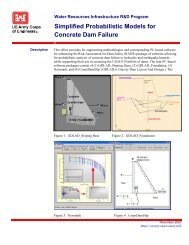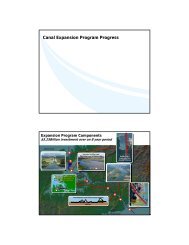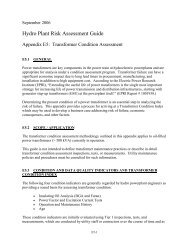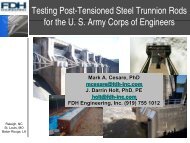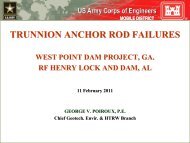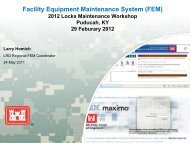Hydro Plant Risk Assessment Guide
Hydro Plant Risk Assessment Guide
Hydro Plant Risk Assessment Guide
Create successful ePaper yourself
Turn your PDF publications into a flip-book with our unique Google optimized e-Paper software.
Table 26 – Improper Field Repair and/or Modifications<br />
Adjustment to<br />
Results<br />
Condition Index Score<br />
Good – No field repairs or modifications done without proper<br />
engineering analysis.<br />
No Change<br />
Moderate – Some minor repairs, not likely to cause failure. Subtract 0.5<br />
Severe – Major modifications that severely compromise the<br />
structural integrity of the valve.<br />
Subtract 1.0<br />
Hydraulic Operators – Functional Operation<br />
Test T2.3.5: Hydraulic Operators – Actuation Performance<br />
The operating performance of the gate or valve in this section is concerned with overall system<br />
performance directly affected by the gate or valve operator itself. Such issues can include<br />
misalignment, speed, and reliability.<br />
Note: If the gate or valve performs unacceptably, and the reason does not relate to the gate or<br />
valve operator itself, score a “No Change” for this section and make an adjustment in the<br />
corresponding Gates – Raising/Lowering Performance or Valves – Actuation Performance<br />
section.<br />
Table 27 – Actuation Performance<br />
Results<br />
Acceptable – Gate or valve actuates from fully open to fully closed<br />
in the required timeframe.<br />
Unacceptable – Valve does not actuate from fully open to fully<br />
closed in the required timeframe. Performance based on some<br />
deficiency of the hydraulic system.<br />
Adjustment to<br />
Condition Index Score<br />
No Change<br />
Subtract 1.0<br />
Test T2.3.6: Hydraulic Operators – Pistons<br />
Dirty hydraulic fluid can cause piston rod to gouge or wear prematurely, especially for pistons<br />
near the bottom of the hydraulic system. Chrome plated piston rods can corrode. Ceramiccoated<br />
pistons with an improperly applied coating can corrode underneath and chip off, which<br />
will cause a failure of the piston seals. Ceramic coatings are also brittle and can crack if the<br />
piston rod is flexed or impacted.<br />
Without taking piston apart, it is difficult to determine the condition of the internal parts. A drift<br />
test can be performed to estimate the performance of the unit. Cylinders that suspend loads<br />
under pressure naturally leak fluid through the internal seals over time, which causes the gates to<br />
drift; the hydraulic system automatically corrects this. This cycle is repeated many times,<br />
sometimes thousands of times per month, causing undo wear on a small a length of the piston<br />
stroke.<br />
E11-25





